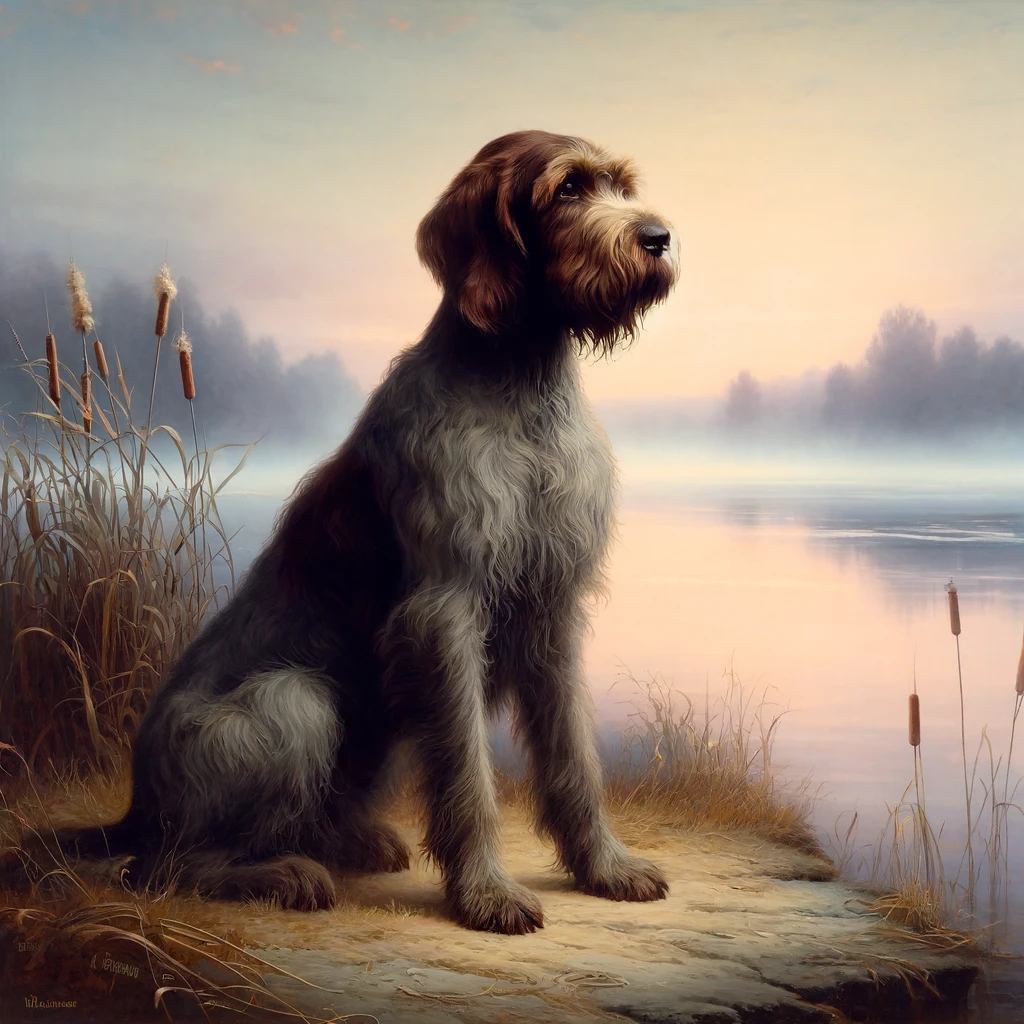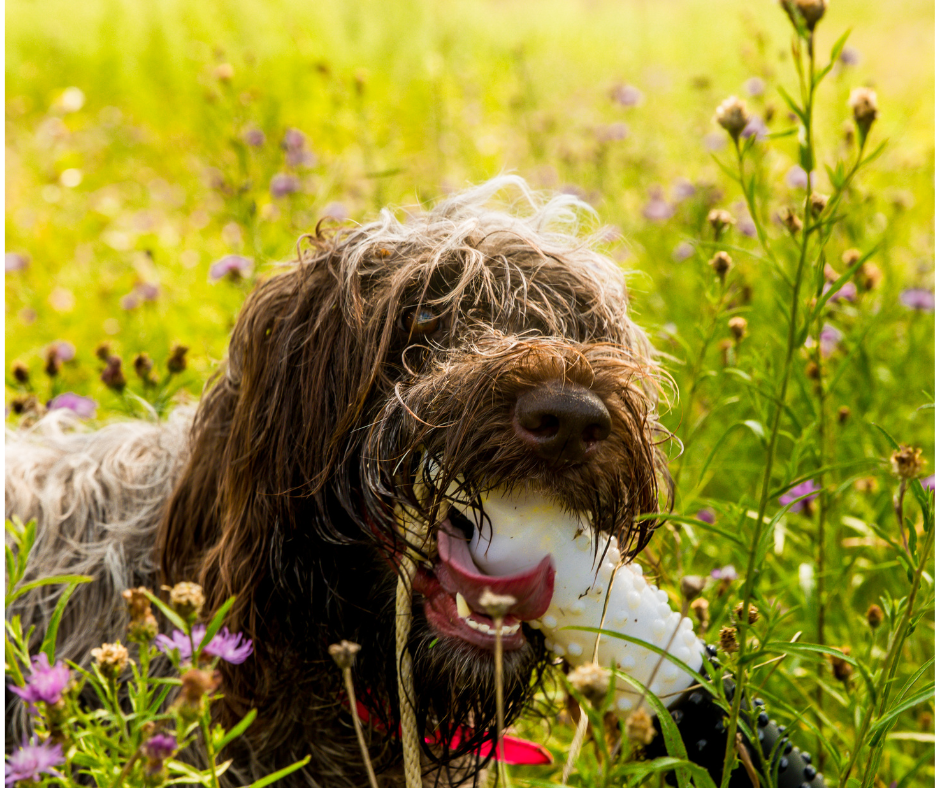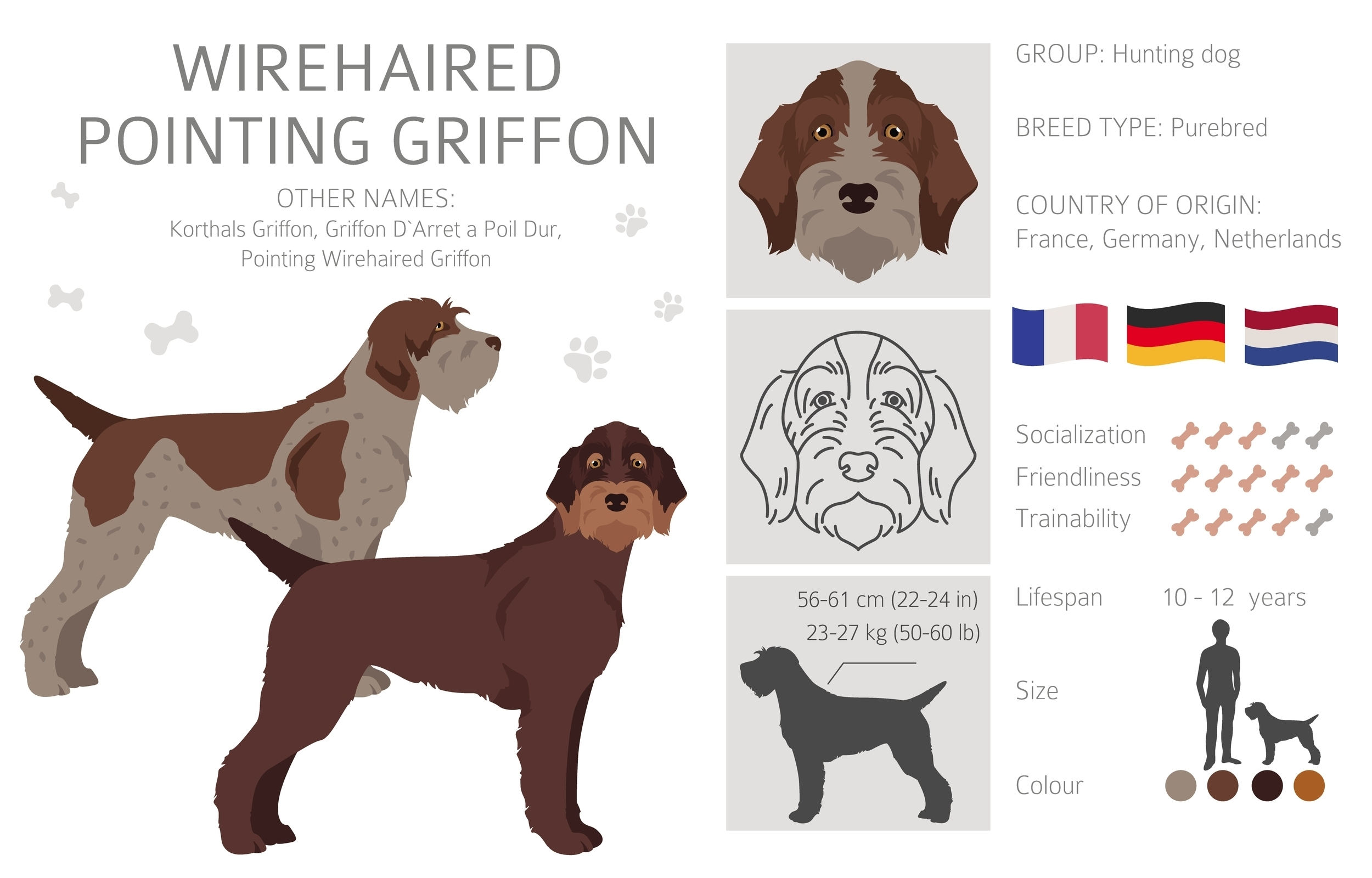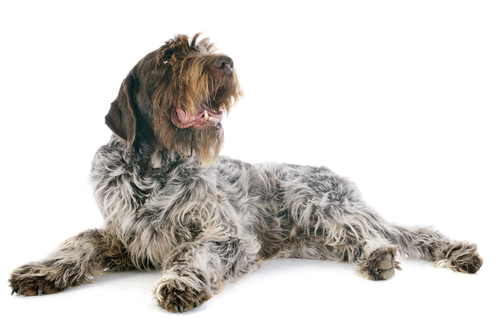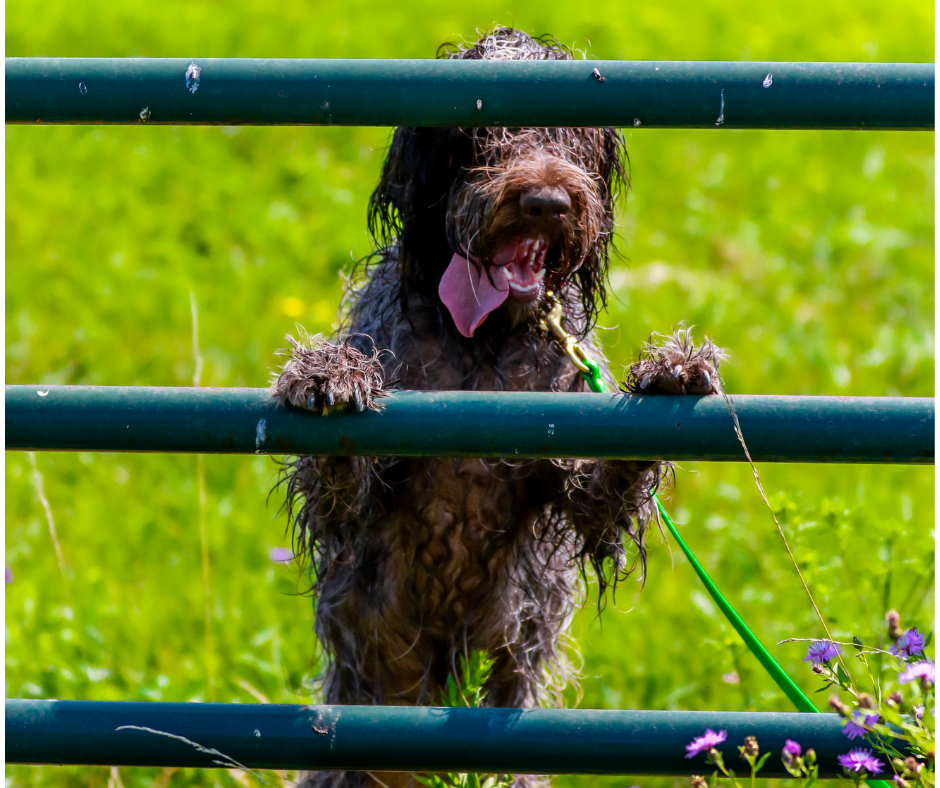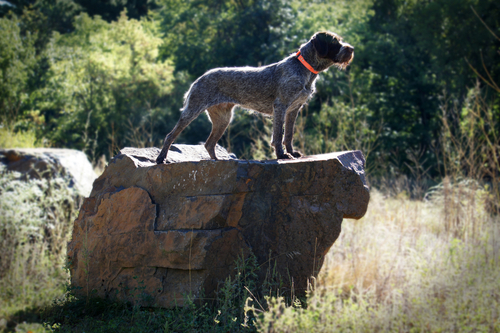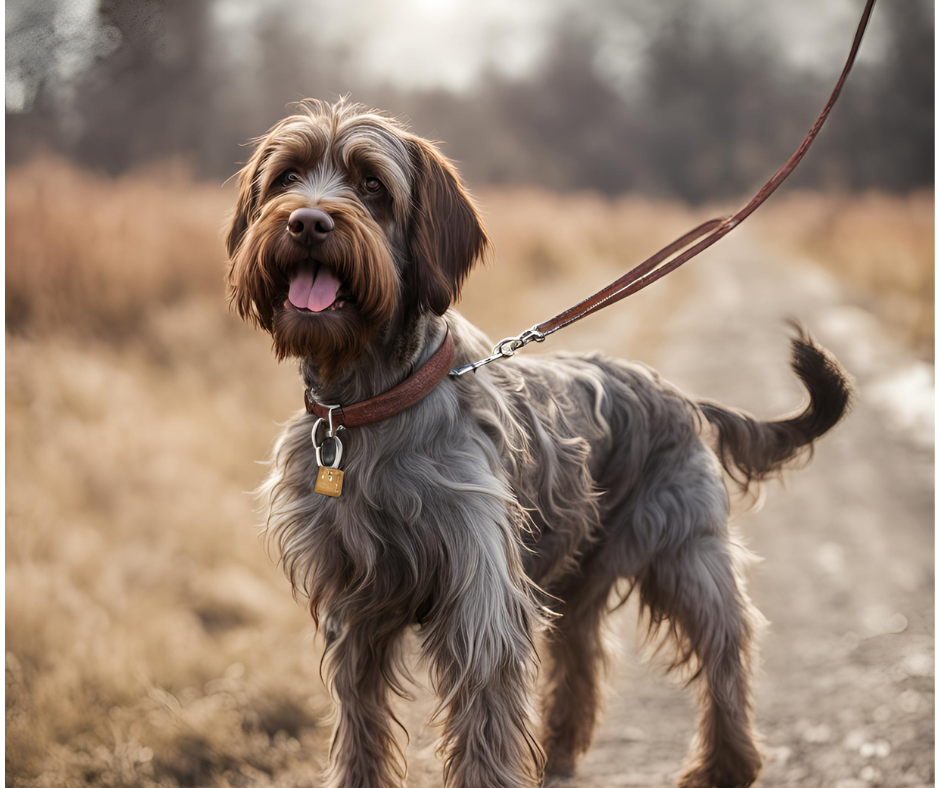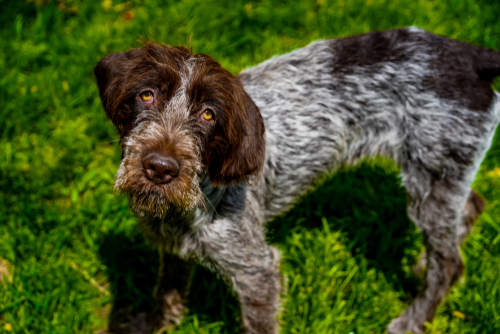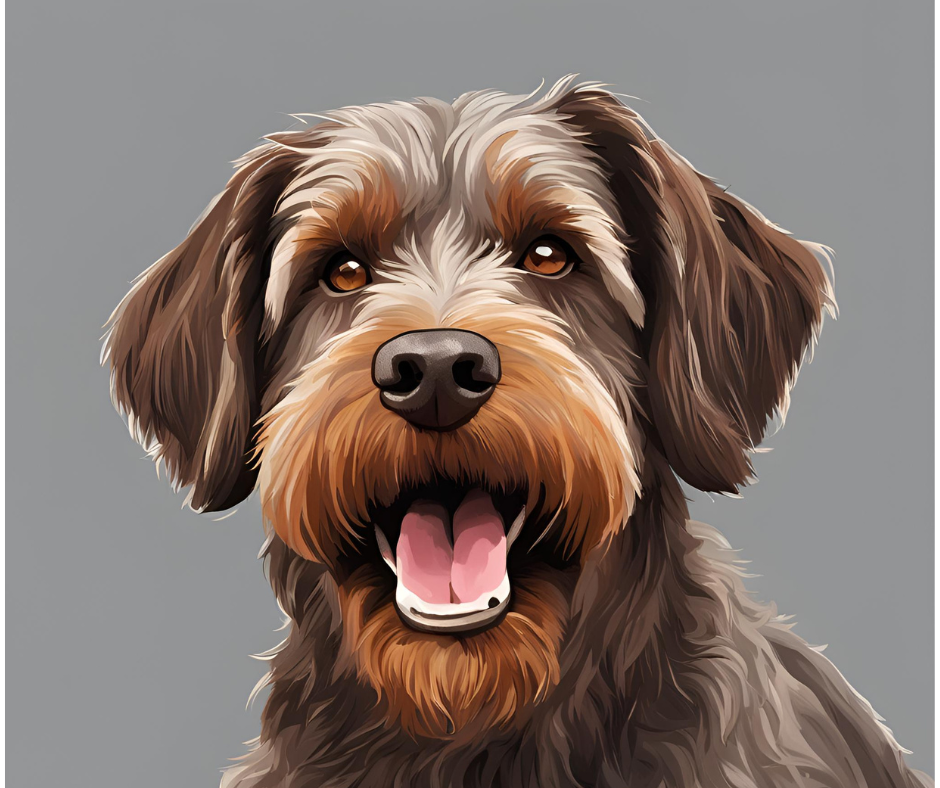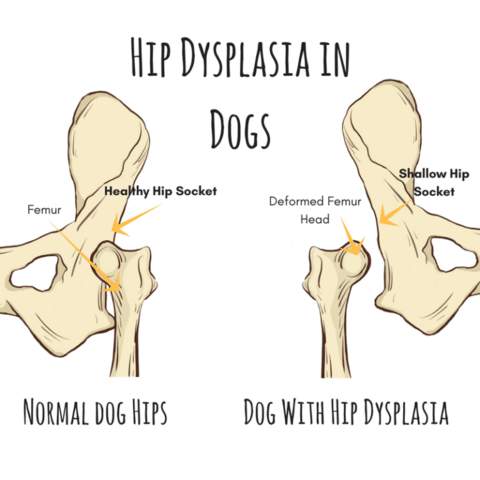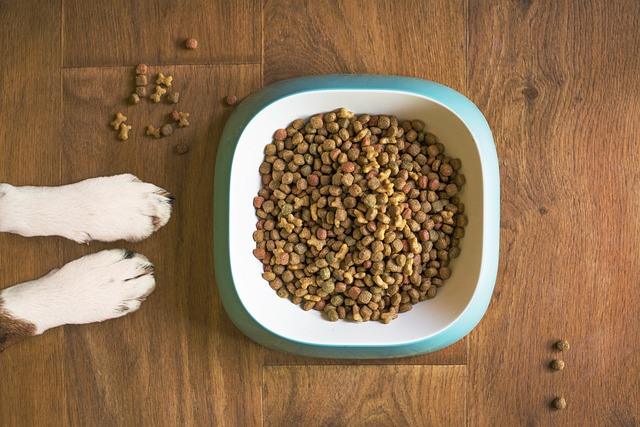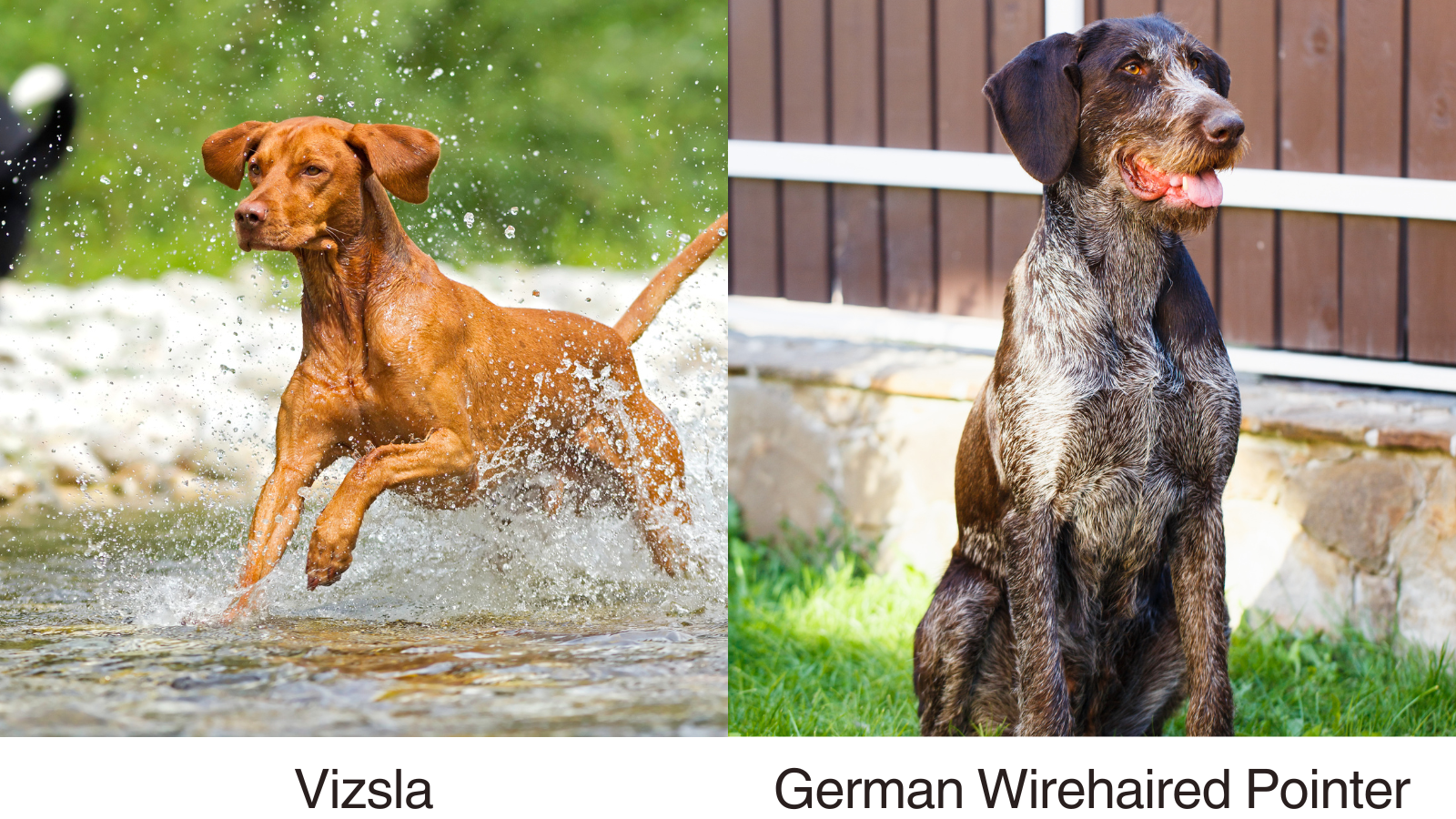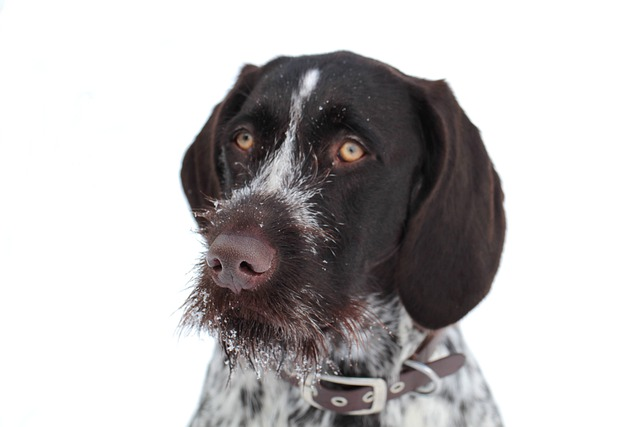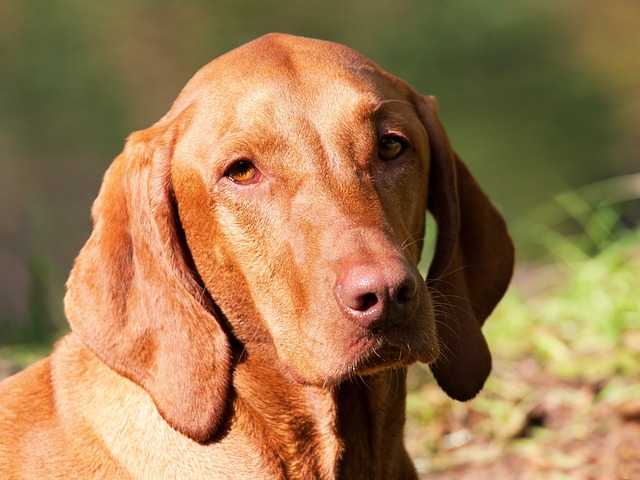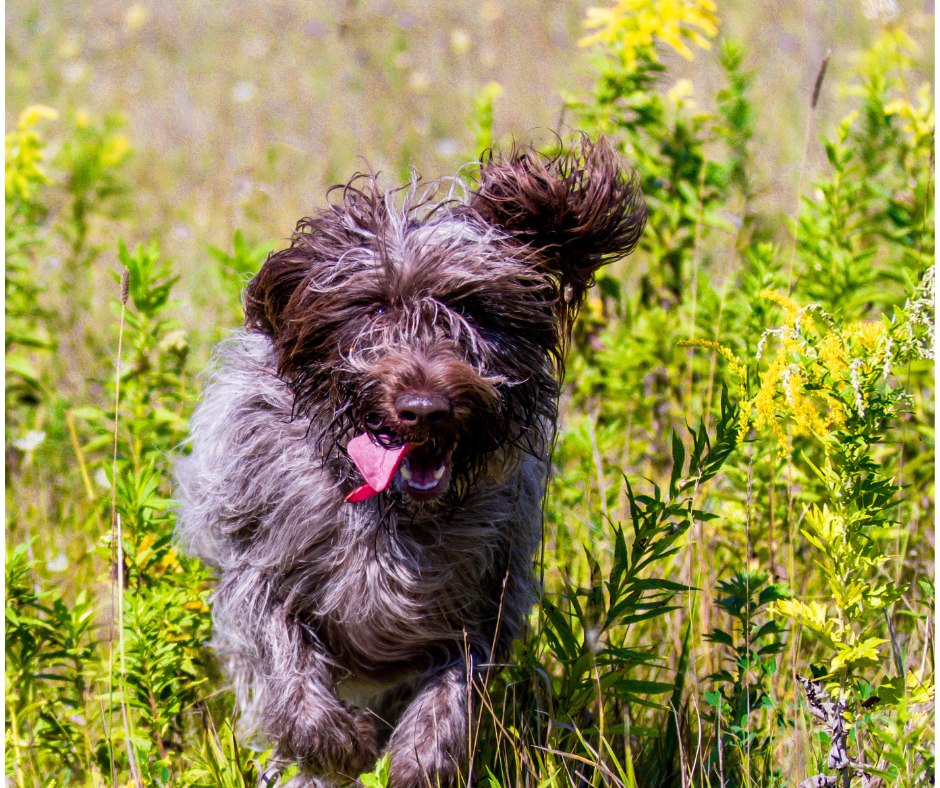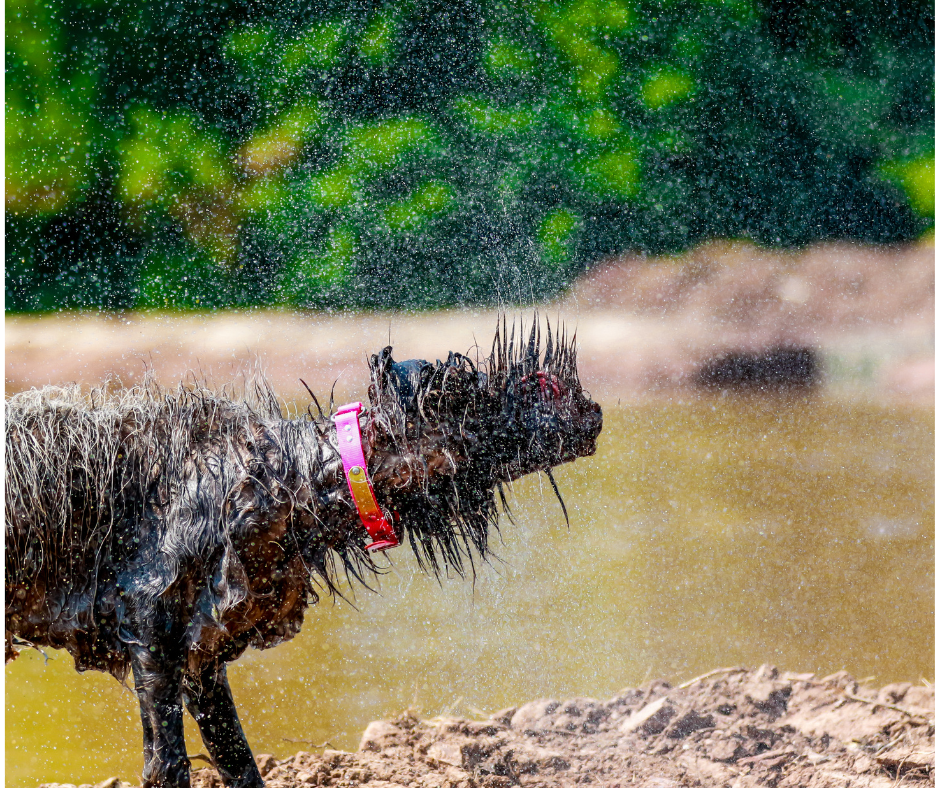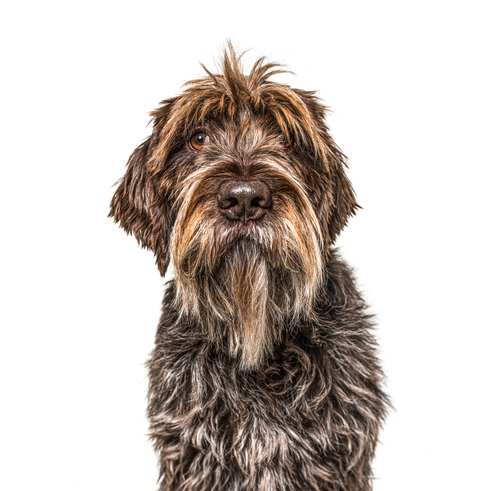Wirehaired Pointing Griffon

In the 19th century, E. K. Korthals set out to create a versatile sporting dog capable of hunting on land and water with a keen sense of smell, leading to the development of the Wirehaired Pointing Griffon (WPG). By 1887, he had established the breed standard through rigorous selection practices.
For over a century, the Wirehaired Pointing Griffon has been celebrated globally for its outstanding hunting abilities and enduring popularity as both a gundog and companion. This breed is known for its affectionate and lively nature, expertly pointing and retrieving game. Despite its initial aloofness with strangers, the WPG is devoted to its family, thriving in activities from agility to search-and-rescue, and is distinguished by its striking yellowish-brown eyes and robust double coat.
Wirehaired Pointing Griffons are energetic and thrive on interaction with their owners, though they may vary in their responses to strangers. They excel in training with positive reinforcement and are great with children and other dogs, though caution is advised with cats. Without sufficient interaction and activity, WPGs can become destructive.
As a breed that loves to be with its family, the WPG is an excellent house dog, enjoying both playtime and relaxation with its loved ones.
Heritage and Honor: Enduring Standards of the Purebred Wirehaired Pointing Griffon
The Wirehaired Pointing Griffon, affectionately known as the WPG, is an enchanting blend of vigor, versatility, and amiability. Renowned for its superb hunting capabilities, this breed emerges as a standout in the sporting dog community. Crafted through intentional breeding to navigate diverse terrains, from marshes to dense forests, the WPG showcases a remarkable adeptness for pointing and retrieving, making it an invaluable companion for any hunting enthusiast.
Beyond the fields and forests, the WPG thrives as a family pet, known for its loyalty and affectionate demeanor. Its friendly personality is complemented by a ruggedly handsome appearance, featuring a distinct, wiry outer coat that not only protects it from harsh weather but also adds to its unique charm. This coat, along with its expressive, intelligent eyes and an ever-wagging tail, endears the breed to both hunters and homebodies alike. Wirehaired pointing griffons today continue to be celebrated for their dual roles as skilled hunting dogs and affectionate family companions, a testament to their versatility and enduring popularity.
The origins of the Wirehaired Pointing Griffon trace back to the 19th century, when a Dutch breeder, Eduard Korthals, driven by a vision to create the ultimate gundog, embarked on a rigorous breeding program. His quest spanned across Germany and France, meticulously selecting and breeding various dogs to cultivate desirable traits such as tenacity, resilience, and a keen olfactory sense. This deliberate and passionate pursuit laid the foundational lineage from which the modern WPG has evolved. Korthals’ dedication to the breed not only refined its physical attributes but also solidified its reputation as a skilled and reliable field companion.
Historical Background of the Wirehaired Pointing Griffon
The Vision of Eduard Korthals
The Wirehaired Pointing Griffon’s historical journey is anchored by the ambitions of Eduard Korthals, the breed’s architect, who embarked on a mission in the late 19th century to craft the perfect gun dog. Korthals was driven by a methodical and passionate approach to breeding a dog that could thrive in the demanding European hunting landscapes while also serving as a steadfast companion.
Read More: The History of Dog Breeding
Foundations of the Breeding Program
Korthals initiated his breeding program around 1874, selecting 20 dogs that showcased traits vital for the kind of gundog he envisioned. These dogs varied in size, coat, and hunting abilities but shared traits suited for the strenuous demands of outdoor activities. The primary aim was to cultivate a breed that could adeptly point and retrieve, especially in watery and wooded areas where game birds like quail and pheasant were prevalent.
Expansion Across Europe
Determined to realize his vision, Korthals traveled extensively across Europe, particularly Germany and France, to identify and integrate suitable dogs into his breeding program. This journey allowed him to tap into a diverse genetic pool, incorporating qualities from German Pointers, Setters, and Spaniels. The culmination of these efforts was a versatile hunting dog characterized by a protective rough coat and a sharp olfactory ability, excelling in both pointing and retrieving tasks.
Formal Recognition and Breed Standards
The Wirehaired Pointing Griffon was officially recognized as a distinct breed in 1887 when Eduard Korthals established the “Korthals Griffon Club” and drafted the breed standard. His strict enforcement of these standards ensured that only dogs meeting his precise criteria were registered, preserving the breed’s essential traits across generations. The breed was further recognized by the American Kennel Club as a purebred in 1951, which helped to formalize and maintain its status and breed quality through regulated standards.
Read More: Dog Breeds Not Recognized by the AKC
Temperament and Dual Purpose
Beyond physical capabilities, Korthals prioritized the breed’s temperament, aiming for a dog that was as effective in the field as it was endearing in the home. This focus on nurturing a gentle yet skilled hunter cemented the breed’s reputation as both an excellent field dog and a devoted companion.
Lasting Legacy and Wirehaired Pointing Griffons Today
The legacy of Eduard Korthals profoundly shapes the modern Wirehaired Pointing Griffon. The breed’s foundational traits—robustness, resilience, and superior hunting skills—remain intact. Korthals’ emphasis on a friendly disposition has made the breed a favored family member, maintaining its role as a proficient hunter and companion. As the breed evolves, it continues to reflect the dual objectives Korthals set out to achieve, demonstrating the enduring influence of his visionary breeding program.
Physical Characteristics of the Wirehaired Pointing Griffon
Understanding the breed characteristics of the Wirehaired Pointing Griffon is essential in appreciating what makes this breed unique. These characteristics include its versatile hunting skills, friendly demeanor, and the physical traits that make it an excellent family companion.
The Wirehaired Pointing Griffon is a medium-sized dog that strikes the perfect balance between size and agility, making it an optimal choice for both hunting and family life. With males averaging 22 to 24 inches in height and females ranging from 20 to 22 inches, and weighing between 50 to 60 pounds, this breed showcases a rough-and-tumble coat and a driven but friendly personality. This classification as a medium-sized pointing breed with a wire-haired coat highlights its distinctive appearance and functional abilities.
Size and Build
The Wirehaired Pointing Griffon (WPG) is distinguished by its size, which plays a crucial role in its efficiency as a hunting dog. Males typically stand 22 to 24 inches at the shoulder, while females are slightly smaller, measuring 20 to 22 inches. The breed’s weight ranges from 50 to 70 pounds, with males generally being heavier. This medium-large size is optimal for maneuvering through rough terrains without exhaustion and is compact enough for mobility in dense underbrush or when getting into hunting vehicles.
Coat Color and Camouflage
The coat of the WPG usually features shades of steel gray with brown markings, although some dogs may exhibit pure white or chestnut patches. These natural, earthy tones help the dogs blend into a variety of outdoor environments, such as autumnal forests and reedy marshes, providing a camouflage that is advantageous during hunts.
Coat Texture and Maintenance
One of the breed’s notable characteristics is its wiry, medium-length double coat. This includes a dense undercoat for insulation in cold weather and a harsh, water-resistant outer coat that offers protection against wet conditions and thorny underbrush. This type of coat is not only practical for different hunting scenarios but also requires minimal grooming, which is ideal for active individuals or families.
Hypoallergenic Qualities
The WPG’s coat is hypoallergenic, a significant advantage for families with allergies. This feature, coupled with the breed’s minimal shedding, makes the WPG an excellent choice for households where allergies or cleanliness are concerns.
Health Considerations
Despite their robust build, Wirehaired Pointing Griffons are prone to certain genetic health issues. Hip dysplasia is a common concern, where the thighbone doesn’t properly fit into the hip joint, potentially leading to arthritis. Regular veterinary care and maintaining a healthy weight are essential for managing this condition. They are also susceptible to ear infections due to their floppy ears and eye conditions such as Progressive Retinal Atrophy (PRA) and entropion. It is crucial to choose a reputable breeder who conducts comprehensive health screenings to ensure the healthiest puppies possible.
Overall Suitability
The Wirehaired Pointing Griffon’s physical traits—size, coat type, and color—combined with its energetic and capable nature, make it an excellent breed for various outdoor and hunting activities. These dogs are designed for stamina, equipped for effective camouflage, and protected by their coat, meeting the demands of active hunters and outdoor enthusiasts. Proper care and attention to their health needs ensure a healthy, active lifestyle, whether working in the field or as a family companion.
Temperament and Personality
Even within the Wirehaired Pointing Griffon breed, it’s important to remember that not all dogs of the same breed will have identical temperaments or needs. Breed enthusiasts particularly admire the Wirehaired Pointing Griffon for its affectionate nature, often describing these dogs as having a humorous personality and an intentionally unkempt, lovable appearance. They also value the completion of recommended health screenings, which signifies responsible breeding and care for these dogs.
Affectionate and Loyal
The Wirehaired Pointing Griffon (WPG) is renowned for its affectionate nature, thriving on interaction with its human family. This breed is known for its loyalty and warmth, quickly becoming a beloved member of any household due to its engaging and loving demeanor.
Intelligence and Trainability
The WPG’s intelligence is a standout feature, making it a quick learner across various training environments. This intelligence, combined with a natural desire to please, enables the breed to excel in obedience and complex tasks required in hunting and field trials. Their ability to respond well to problem-solving games and advanced training techniques also helps keep them mentally stimulated and satisfied.
Read More: A Guide to Behavioral Training Dogs
High Energy and Activity Needs
Possessing a vibrant zest for life, the WPG has high energy levels and requires regular, engaging exercise. Activities like long hikes, jogging, and interactive play are ideal for this breed, aligning perfectly with the lifestyle of active individuals or families who embrace the outdoors.
Sociability with Animals
The WPG typically shows a friendly demeanor towards other dogs and can adapt well to other household pets when introduced properly at an early age. This sociability makes them excellent for multi-pet homes, fostering a peaceful and social environment.
Gentleness with Children
The breed’s gentle and patient nature makes it well-suited for families with children. They are protective yet gentle and often form deep, enduring bonds with kids, becoming dedicated companions. Supervision is recommended during interactions to ensure safety and positive experiences.
Sensitivity to Mood
Wirehaired Pointing Griffons are acutely perceptive to the mood and tone of their home environment, often displaying empathy and reacting to changes within the household. They thrive with positive reinforcement training approaches, as harsh methods can cause timidity and distress.
Independent Streak
While generally compliant and eager to please, the WPG can display a level of independence, occasionally showing stubbornness if training lacks variety or becomes tedious. To keep them engaged and prevent boredom, it is crucial to make training sessions short, varied, and interactive.
These traits — intelligence, vitality, sociability, child-friendliness, sensitivity, and a touch of independence — highlight the Wirehaired Pointing Griffon’s adaptability and capability as both a companion for outdoor activities and a cherished family pet. The blend of these characteristics makes the WPG fit well into a variety of roles, from active outdoor engagement to fulfilling emotional roles within a family setting.
Grooming Needs
Maintaining the distinctive rough coat of the Wirehaired Pointing Griffon (WPG) requires specific grooming practices, both to preserve the coat’s unique texture and to ensure the dog’s comfort and health. The grooming routine for a WPG involves regular brushing, periodic bathing, and careful attention to prevent matting and manage shedding.
Brushing
Regular brushing is crucial for the WPG, not only to remove dirt and loose fur but also to prevent the formation of mats, which can cause skin irritation and discomfort. The WPG’s coat, characterized by its coarse, wiry texture, should be brushed at least two to three times a week with a slicker brush or a pin brush. These types of brushes are effective at reaching through the dense outer coat to the softer undercoat, capturing loose hairs without damaging the wiry top coat.
During brushing, it is essential to be thorough and gentle, working through the entire coat systematically. Start from the head and move towards the tail, paying particular attention to areas prone to tangling such as behind the ears, under the arms, and around the neck where the collar rests. For areas that are particularly prone to matting, a metal comb can be used to gently work out tangles, taking care not to pull too hard, which could cause discomfort or damage to the skin.
Bathing
Bathing a WPG should not be a frequent part of the grooming routine, as over-bathing can strip the coat of its natural oils, leading to dryness and potential skin issues. Typically, bathing every three to four months is sufficient, unless the dog has gotten exceptionally dirty or has a specific skin condition that requires more frequent bathing as advised by a veterinarian.
When bathing, it’s important to use a shampoo formulated for dogs, ideally one that caters to wiry coats. These shampoos help maintain the coat’s natural texture while ensuring that the skin remains hydrated and protected. After applying shampoo, thoroughly rinse the coat to prevent any residue, which can cause irritation and dull the coat’s appearance. Following the bath, gently towel-dry the WPG, and if necessary, use a low-heat setting on a hairdryer to help dry the coat completely. Avoid high heat as it can damage the fur and irritate the skin.
Managing Shedding
Despite their rough coat, WPGs do shed, though generally less than many other dog breeds. To manage shedding and keep the home hair-free, regular brushing as detailed above is the most effective method. This not only helps to remove loose fur but also distributes skin oils throughout the coat, keeping it healthy and reducing the amount of hair shed.
During the shedding seasons, typically spring and fall, you may find it necessary to brush your WPG more frequently to manage the increased amount of loose hair. During these times, integrating a de-shedding tool once a week can help remove the undercoat and loose fur without damaging the top coat.
Additional Tips
– Always check the paws during grooming sessions for debris or matting between the pads, which can cause discomfort or even pain.
– Regularly trim the nails to prevent overgrowth that can lead to walking difficulties or discomfort.
– Inspect the ears weekly for signs of wax buildup, irritation, or infection, particularly because the WPG’s floppy ears can trap moisture and debris.
By adhering to these grooming practices, pet owners of Wirehaired Pointing Griffons can ensure their pets not only look their best but are also comfortable and healthy. This attention to grooming also enhances the bond between the dog and owner, making each grooming session a rewarding experience for both.
As grooming is a critical aspect of caring for a WPG, so too is ensuring they receive adequate training and exercise, which will be discussed in the following section.
Training and Exercise
The Wirehaired Pointing Griffon, with its sharp intellect and vibrant energy, thrives on consistent training and ample exercise. Understanding how to effectively harness these traits through specific training methods and exercise routines not only enhances the dog’s skills but also deepens the bond between pet and owner. In agility and obedience training, dogs excel, showcasing their exceptional performance and adaptability in learning new tasks and commands.
Training Methods
Training a Wirehaired Pointing Griffon should begin early, as their eagerness to please and quick learning abilities make them highly responsive to early socialization and obedience training. Positive reinforcement is key. This breed responds exceptionally well to rewards such as treats, praise, and play, which encourage and reinforce good behavior without fostering fear or aggression.
Start with basic commands like sit, stay, come, and down. Because of their intelligent nature, WPGs can quickly move to more complex commands and tricks. They excel in agility training, which not only mentally stimulates them but also provides the physical exercise they need. Incorporating training into play makes learning enjoyable and less of a chore for both the dog and trainer. For instance, hiding treats during a play session can be a fun way to teach commands like ‘find’ or ‘fetch’.
Consistency is crucial in training sessions. Establish and maintain clear rules and boundaries to help your WPG understand what is expected of them. This consistency helps to avoid confusion and reinforces the learning process. Training sessions should be short to keep the dog’s attention high. Typically, 10 to 15 minutes of focused training time several times a day is ideal.
Socialization is another critical aspect of training, especially in the puppy stage. Exposing your WPG to various environments, people, and other animals helps them become well-adjusted and socially confident adults. This exposure reduces anxiety and fearfulness in unfamiliar situations and promotes a calm demeanor.
Read More: Dog Training 101
Exercise Needs
The Wirehaired Pointing Griffon is an active breed that requires regular and rigorous exercise to manage its energy levels. Without adequate exercise, these dogs can develop behavioral issues such as excessive barking, digging, or other destructive behaviors. A daily exercise regimen that satisfies their stamina and agility is beneficial.
A mix of physical and mental activities is ideal. Daily walks are essential, but these should be complemented with runs, hikes, or swims. WPGs are known for their swimming ability, so activities that include water are excellent for keeping them fit and happy. Games like fetch and tug-of-war also help to use up some of their boundless energy while strengthening your bond.
For owners who enjoy outdoor activities, taking your Griffon on a trail run or a biking session can be a perfect way for both of you to get exercise. These dogs also excel in dog sports like flyball, tracking, and field trials, which are fantastic outlets for their energy and intelligence.
Mental Stimulation
Mental stimulation is just as important as physical exercise. WPGs are clever dogs that can easily become bored if not properly stimulated. Puzzle toys, training new tricks, and regular obedience sessions can keep their minds active. Teaching them jobs like fetching the newspaper, sorting laundry, or even complex tricks can engage their minds and reduce incidences of misbehavior due to boredom.
By ensuring that your Wirehaired Pointing Griffon is well-trained and adequately exercised, you nurture a dog that is not only physically fit and skilled but also emotionally content and socially well-adapted. This leads to a healthier, happier life and a more harmonious home environment. Now, let’s move on to understand the typical health concerns associated with the breed and how proper nutrition plays a role in their overall wellness.
Health and Nutrition
As your dog ages, it’s crucial to adjust their diet to fit their changing nutritional needs. Understanding your dog’s age is essential in planning a healthy feeding schedule and conducting health screenings at appropriate life stages. This ensures that your canine friend receives the right balance of nutrients to maintain optimal health throughout their life.
Health and Nutrition
The Wirehaired Pointing Griffon is generally considered a robust breed, but like all dogs, they have specific health considerations that owners should be aware of. Focused attention on their health and nutrition will contribute significantly to a long and vibrant life.
Common Health Issues
Wirehaired Pointing Griffons are prone to a few genetic health problems that prospective owners should be aware of:
1. Hip Dysplasia: This is a common condition in many dog breeds where the hip joint does not fit into the socket properly. This can lead to arthritis or lameness, and it’s often discernible by the dog showing discomfort during or after exercise or difficulty standing up. Regular vet check-ups and maintaining a healthy weight can reduce the strain on the joints and alleviate some symptoms.
2. Ear Infections: Due to their floppy ears, WPGs are more susceptible to ear infections. Moisture and bacteria can easily become trapped inside their ear canals. Regular cleaning and drying of their ears, especially after swimming or bathing, are essential preventative measures.
3. Ectropion: This is a condition where the lower eyelid droops outward, exposing the eye to potential irritation and infections. Regular checks and cleaning of the eyes can prevent serious complications.
4. Hypothyroidism: This thyroid disorder is also seen in WPGs and can lead to issues such as obesity, lethargy, and coat problems. A simple blood test can diagnose the condition, which is typically manageable with medication.
Preventative measures, including regular veterinary check-ups, vaccinations, and parasite control, are vital in catching and managing these conditions early. Exercise moderation, particularly in younger dogs, can also prevent joint and bone problems later in life.
Nutritional Needs
A well-balanced diet is crucial for the Wirehaired Pointing Griffon, particularly one that suits their active lifestyle:
– Protein: High-quality animal protein should form the bulk of their diet to support muscle growth and maintenance. Sources like chicken, turkey, beef, and fish are excellent choices.
– Fats: Healthy fats are necessary for energy and coat health. Sources such as fish oil can provide omega-3 fatty acids which help maintain the coat’s lushness and support joint health.
– Carbohydrates: Carbs provide energy and should come from digestible sources like sweet potatoes and brown rice to ensure they don’t cause unnecessary weight gain.
– Vitamins and Minerals: A balanced intake of essential vitamins and minerals supports overall health. Supplements might be necessary based on specific health needs as determined by your vet.
– Caloric Intake: Active breeds like the WPG require more calories. However, the exact amount will vary based on the dog’s age, weight, and activity level. It’s important to monitor their weight regularly to adjust food intake as necessary to avoid obesity.
Special considerations should be given to feeding puppies and senior dogs. Puppies require more calories and essential nutrients in smaller, more frequent meals to support their growth and development. In contrast, seniors might need fewer calories to prevent weight gain due to decreased activity levels.
By maintaining a keen awareness of the health issues particular to the Wirehaired Pointing Griffon and providing a diet that supports their energetic lifestyle, owners can ensure their companions lead healthy, happy lives. This attention to health and nutrition is crucial in preventing many common ailments and enhances the overall quality of life for these engaging and loyal dogs. Now, let’s move on to compare the Wirehaired Pointing Griffon with similar breeds to aid potential owners in making an informed decision. Discuss scenarios where another breed might be more suitable.
Read More: How to Choose the Best Dry Dog Food
Similar Breeds and Considerations
Continuing from the Wirehaired Pointing Griffon’s profile, it’s beneficial to compare it with other breeds to fully understand its uniqueness and suitability for potential owners. Two similar breeds worth considering are the German Wirehaired Pointer and the Vizsla. Each of these breeds shares some characteristics with the Wirehaired Pointing Griffon, yet they have distinct differences that might make one more suitable than another depending on an owner’s lifestyle and expectations.
Comparison with German Wirehaired Pointer
Temperament:
The German Wirehaired Pointer (GWP) is known for its energetic, determined, and intelligent personality, much like the Wirehaired Pointing Griffon. However, GWPs often display a more assertive temperament and can be more dominant compared to the typically friendly and less assertive Griffon. This makes the GWP better suited for experienced dog owners who can establish a firm, consistent leadership and are familiar with managing a strong-willed dog.
Care Needs:
Both breeds have similar grooming needs due to their wiry coats, which require regular brushing and occasional stripping to maintain their condition and prevent matting. However, the GWP’s coat is generally a bit denser and may require more frequent grooming. In terms of exercise, both breeds are highly energetic and require significant daily activity, but the GWP may have slightly higher endurance and can be more demanding in its need for physical activity.
Owner Suitability:
Owners who enjoy outdoor activities and are looking for a dog that can participate in more intense activities such as hiking, hunting, and competitive sports might find the GWP a better fit. Its stamina and robust nature equip it well for rigorous outdoor adventures, making it an excellent companion for active individuals or families.
Comparison with Vizsla
Temperament:
The Vizsla is another active breed but tends to be more affectionate and sensitive compared to the Wirehaired Pointing Griffon. Vizslas are known for their strong attachment to their families, often described as “velcro” dogs due to their desire to be close to their humans. This trait can make them more prone to separation anxiety if left alone for long periods. In contrast, while the Griffon is loyal and loving, it is typically more independent.
Care Needs:
Vizslas have short, smooth coats which are considerably easier to maintain than the wiry coat of the Griffon. This makes them a good choice for people who prefer less grooming responsibility. However, like the Griffon, Vizslas require ample exercise to manage their high energy levels. They excel in various dog sports and activities, which helps in burning off their energy and keeping them mentally stimulated.
Owner Suitability:
The Vizsla’s sensitive nature and need for close human interaction make them particularly suitable for families that can provide them with constant companionship and are able to involve their dog in most daily activities. They are less ideal for people who travel frequently or have long work hours unless arrangements are made to ensure the dog is not left alone too often.
In considering these breeds alongside the Wirehaired Pointing Griffon, potential owners must reflect on their lifestyle, experience with dogs, and the amount of time they can dedicate to care, training, and affection. Always select a reputable breeder. Griffon breeders will be able to provide health and shot records. Each breed presents unique qualities that could be better suited to different home environments and owner expectations. Understanding these differences is crucial in selecting a breed that aligns well with one’s lifestyle and can integrate smoothly into the family.
FAQs about the Wirehaired Pointing Griffon
What is the lifespan of a Wirehaired Pointing Griffon?
Wirehaired Pointing Griffons typically enjoy a lifespan of around 12 to 15 years. This duration is influenced by various factors such as genetics, diet, and overall health care. Providing a balanced diet, regular exercise, and preventive veterinary care can help maximize their life expectancy.
How well do Wirehaired Pointing Griffons get along with children?
Wirehaired Pointing Griffons are known for their friendly and patient demeanor, making them excellent companions for families with children. They are generally gentle and playful, which suits the energy levels of younger family members. However, as with all breeds, it’s important to supervise interactions between dogs and young children to ensure safety and teach respectful boundaries.
Are Wirehaired Pointing Griffons good with other pets?
Generally, Wirehaired Pointing Griffons do well with other pets, especially if they are raised together from a young age. Their social and accommodating nature makes them capable of forming strong bonds with other dogs. Caution might be necessary with smaller pets due to their hunting instincts, but proper training and socialization can mitigate potential issues.
What are some training challenges with Wirehaired Pointing Griffons?
While Wirehaired Pointing Griffons are eager to please and intelligent, their occasional stubbornness can be challenging, especially when Wirehaired Pointing Griffons bark to express their needs during training sessions. Consistency and patience are key in handling this breed effectively. Positive reinforcement techniques are most effective, as they respond well to rewards and praise. Early socialization and obedience training are crucial for developing a well-mannered and sociable dog.
Can Wirehaired Pointing Griffons live in an apartment?
Wirehaired Pointing Griffons can adapt to apartment living as long as their physical and mental stimulation needs are met. They are active dogs that require regular exercise to prevent boredom and disruptive behavior. Daily walks, play sessions, and mental challenges are essential. Without these, they may exhibit unwanted behaviors such as barking and chewing.
What are the grooming needs of a Wirehaired Pointing Griffon?
Their distinctive wiry coat requires regular grooming to maintain its condition and prevent matting. Brushing a couple of times a week and occasional professional grooming to strip the coat helps manage shedding and keeps the coat healthy. Regular ear cleaning, nail trimming, and dental care are also vital to their overall health.
How much exercise does a Wirehaired Pointing Griffon need?
Wirehaired Pointing Griffons are highly energetic and require ample exercise to remain healthy and happy. Ideally, they should have at least an hour of vigorous exercise each day. Activities like running, hiking, and retrieval games not only satisfy their physical needs but also provide mental stimulation.
What health issues are Wirehaired Pointing Griffons prone to?
This breed can be susceptible to certain hereditary health issues, including hip dysplasia, entropion, and otitis externa. Regular check-ups with a veterinarian can help catch and manage these conditions early on. Additionally, maintaining a healthy weight and active lifestyle contributes to overall health longevity.
Are Wirehaired Pointing Griffons easy to train?
Yes, Wirehaired Pointing Griffons are generally easy to train due to their intelligence and eagerness to please. They excel in obedience, agility, and field trials, reflecting their versatility and trainability. Starting training early and using positive reinforcement techniques can yield excellent results.
This segment addresses some of the most common inquiries about the Wirehaired Pointing Griffon, helping prospective owners understand what to expect when considering this breed. These responses should assist in making an informed decision on whether a Wirehaired Pointing Griffon is a suitable addition to their family.
Conclusion: Is the Wirehaired Pointing Griffon Right for You?
Selecting a dog breed that fits your lifestyle and household is crucial. The Wirehaired Pointing Griffon (WPG) is a distinctive breed with characteristics and needs that make it ideal for certain types of owners but less suitable for others.
Active Lifestyle Compatibility: Wirehaired Pointing Griffons thrive in environments where they can expend their abundant energy. Their need for physical activity is significant, requiring more than just a daily walk. They excel in homes that can provide space and time for vigorous exercise such as running, hiking, or engaging in dog sports like agility and field trials. If you lead an active lifestyle and seek a companion to share in your outdoor adventures, a WPG might be the perfect fit.
Time for Training and Socialization: WPGs are intelligent and generally eager to please, which makes them relatively easy to train. However, their sometimes stubborn streak means they require consistent, patient training methods. The ideal owner should be someone who enjoys and understands the nuances of dog training, and who is prepared to invest the time in training and socializing their pet from an early age.
Grooming Commitment: The unique, wiry coat of the WPG requires regular maintenance to keep it in good condition and to avoid matting. This includes brushing a couple of times a week and occasional professional grooming. Prospective owners must be prepared to commit to this grooming schedule. Additionally, their outdoor activities can lead to more frequent bathing to remove dirt and debris from their coats.
Family Dynamics: WPGs are known for their loyalty and affectionate nature, making them excellent family pets. They generally get along well with children, often participating eagerly in play and activities. Families with young children or other pets will find the WPG to be a loving addition to their household, provided that there is supervision to ensure safe interactions.
Housing Considerations: While adaptable to various living situations, WPGs do best in homes where they have room to move. A house with a yard is ideal, though they can adjust to apartment living if their exercise needs are met. They are not suited to being left alone for long periods, as they can become bored and destructive. Therefore, potential owners should consider their ability to provide enough attention and companionship.
Companion for the Elderly or Very Busy People: WPGs may not be the best choice for elderly individuals or people with very hectic schedules who cannot guarantee active engagement and regular exercise. Their high energy and exercise requirements could be overwhelming for people who are looking for a more sedate or low-maintenance pet.
In assessing whether a Wirehaired Pointing Griffon is the right dog for you, consider not only your current lifestyle but also your ability to meet the needs of this vibrant breed throughout its life. Ownership of a WPG is a rewarding commitment that demands time, energy, and affection. For the right person or family, a Wirehaired Pointing Griffon can be a joyous and fulfilling lifelong companion, fully integrated into the rhythms of daily life and activity.
- Group AKC Sporting
- Origin France, Netherlands
- Size Medium, Large
- Weight 45 to 70 pounds
- Coat Length Medium
- Coat Type Double, Wiry
- Colors Brown & Gray,Chestnut & Gray
- Other Names Korthals Griffon, Poil Dur, Korthals
- Temperament Gentle, Loyal, Proud, Trainable, Vigilant, Intelligent














